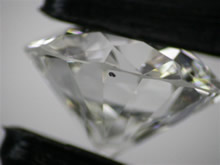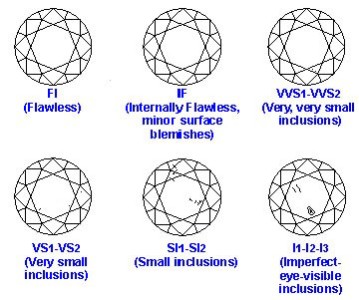Virtually all natural diamonds contain identifying characteristics, many of which are invisible to the unaided eye. Clarity is the degree to which a stone is free from external marks called blemishes and internal features called inclusions. Inclusions normally have a greater impact on grade, value, beauty, and durability than do blemishes.
Click here for our detail discussion on inclusions and blemishes
When shopping for a diamond, the goal is to decide what level of these imperfections is appropriate for this particular purchase. A certain level of imperfections can be to your advantage since they act as a fingerprint to help identify your diamond. These imperfections can lower the price of the diamond to make it affordable without affecting its beauty to your eye.
The position of an inclusion affects how readily it can be seen. Cutters call the area seen through the table the heart of the stone and make every effort to cut a stone so that inclusions are not visible through the table of the finished stone. The preferred position for inclusions is under the bezel facets or near the girdle because they are less noticeable there.
Sometimes inclusions are located where they cause multiple reflections in the pavilion facets when you look at the stone from the top. Such reflectors lower the clarity grade more than similar non-reflecting inclusions.
The following diagrams show what inclusions and blemishes look like in the different GIA clarity grades when viewed with 10X magnification. You can use a loupe or microscope to see these characteristics, many of which will not be visible to the unaided eye.
An untrained person will have a very difficult time trying to find inclusions or blemishes in FI, IF, VVS1, or VVS2 grades even with a microscope. There is no visible difference in beauty or appearance once the clarity is clean to the eye with VS clarity. These high clarity grades should only be considered if you are willing to pay the price for higher quality knowing that does not have an impact on appearance.
 VS1 and VS2 graded stones have very small inclusions that are difficult to find even when viewed with 10X magnification. Typical inclusions are small crystals or feathers, distinct clouds and groups of pinpoints. They do not impact the diamond’s beauty and are very high quality diamonds.
VS1 and VS2 graded stones have very small inclusions that are difficult to find even when viewed with 10X magnification. Typical inclusions are small crystals or feathers, distinct clouds and groups of pinpoints. They do not impact the diamond’s beauty and are very high quality diamonds.
SI1 and SI2 are the two most common grades for the typical buyer. These grades have inclusions or blemishes when viewed with 10X magnification. Most SI1 clarity diamonds should be “eye-clean,” which means the flaws can’t be seen with the unaided eye when viewed from the top. These are good quality diamonds and provide great beauty at a very reasonable price. Most SI2 clarity diamonds have inclusions visible to the unaided eye.
Caution! There are some SI clarity diamonds that have inclusions easily visible to the unaided eye and should only be used for earrings or pendants, not for engagement rings.
I1, I2 and I3 are commercial grade diamonds and should be avoided except perhaps for I1 in earrings. These diamonds have inclusions that impact the beauty and durability of the diamond.. Many people unwittingly buy I1 and I2 stones in uncertified diamond rings, but if you shop carefully you can buy an eye-clean SI1 stone for a great price and not worry about clarity. The photos below show display some I1 and I2 clarity diamonds.
Advice: For diamonds with many facets (i.e., round brilliant), it is extremely difficult to see the difference between SI1 and higher grades even with a loupe or microscope. Therefore, target SI1 or VS2 as the best clarity values with outstanding beauty. For step cut shapes like emeralds and Asschers, we recommend at least VS2 clarity diamonds since these stones are so transparent and inclusions are easier to see with the eye.
A diamond is the hardest thing in the world, but not the toughest. Diamonds can get abrasions or even chipped through normal wear and tear. When diamonds rub together while being stored, they may get scratched or abraded (minute scratches and pits along facet edges). Be careful any time that diamonds might come in contact with another diamond. Diamonds are valuable objects and should not be abused.
We frequently get calls from clients and shoppers who see a whitish line about a third of the way up from the bottom of the diamond. The clients are nervous about this line, thinking it is a crack in the diamond. This line is simply the reflection of the girdle in the pavilion facets. The pavilion acts as an internal mirror and is simply reflecting the girdle. There is nothing in the diamond, and this is a normal reflection that should appear in almost every diamond shape. Notice it when you purchase and you will not have that frightful experience when you “discover” it months later.
 Diamonds are clarity graded face up (looking at the top of the diamond), not from the side or bottom of the diamond. We have the most problem with clarity where the inclusions are not visible with the eye from the top of the diamond but are visible from the side. When viewing a diamond from the side, the middle third of the diamond is generally very transparent.
Diamonds are clarity graded face up (looking at the top of the diamond), not from the side or bottom of the diamond. We have the most problem with clarity where the inclusions are not visible with the eye from the top of the diamond but are visible from the side. When viewing a diamond from the side, the middle third of the diamond is generally very transparent.
If an inclusion is in this part of the diamond and happens to be turned broadside to your view, it can be much more visible than when viewed from the top where there are many facets to hide its appearance. If the diamond is going to be visible from the side in the setting, make sure your diamond is clean to the eye from the top and the side, regardless of what clarity grade it has.
Many of our clients have come to us with the misinformation that extremely high clarity is necessary for a diamond to have great sparkle. Often they were shown a VVS clarity stone in a store and appeared to be brighter and have more sparkle than the VS2 or SI1 diamond it was being compared to. Once a diamond is clean to the eye, it is the cut of the diamond that produces the brilliance and sparkle, not higher clarity grades.
Some of our clients insist on IF or VVS clarity. Many are surprised to find out that all diamonds have inclusions. A Flawless diamond just means that the inclusions are not visible at 10x magnification. Turn the microscope up to 20x or 30x magnification and the inclusions and blemishes become visible.
We try to point out that they are paying a high price premium for one or two minute pinpoints under a microscope that are ten times smaller than the particles of dust floating in the air. We just hate to see a college student working three jobs feel that he has to buy VVS clarity to get a beautiful diamond. Our advice is to put their hard earned dollars into things that are visible and add to the beauty of the diamond (size, color, cut) rather than a clarity grade on the certification that has no impact on the diamond’s beauty.
There are several techniques that are used to “enhance” the clarity of diamonds so they appear better to the eye. These techniques impact the value of the diamonds so you need to be knowledge of them to protect yourself from making an expensive mistake.
Click here to our discussion of laser drilled and fracture filled clarity enhancement techniques and what you need to be aware of when shopping for your diamond.


